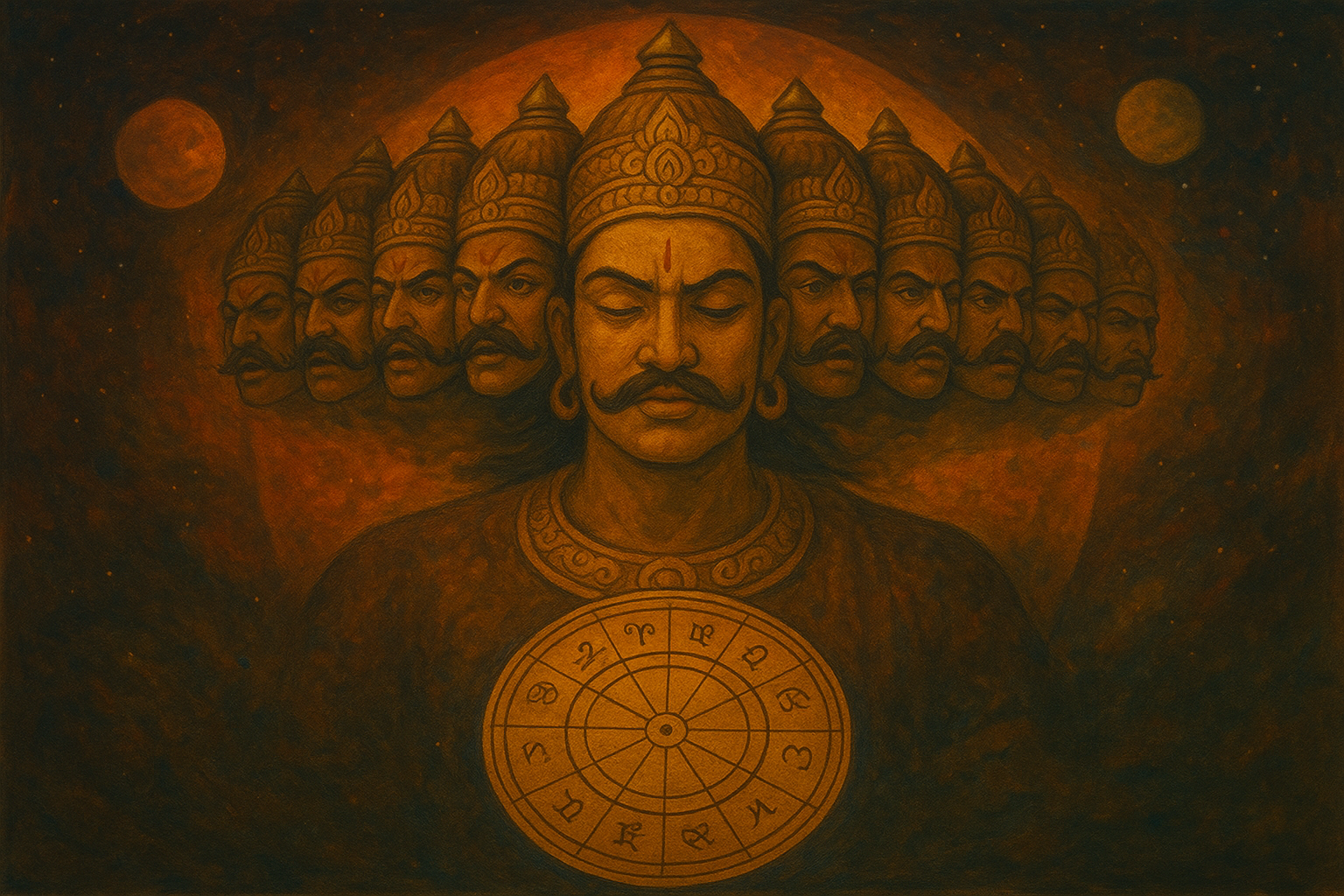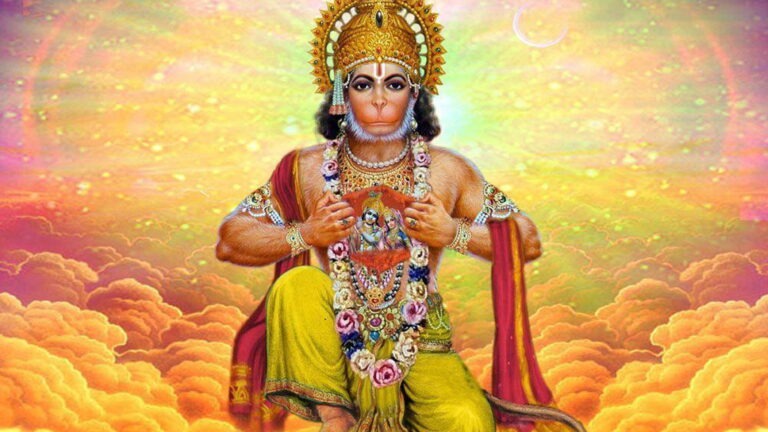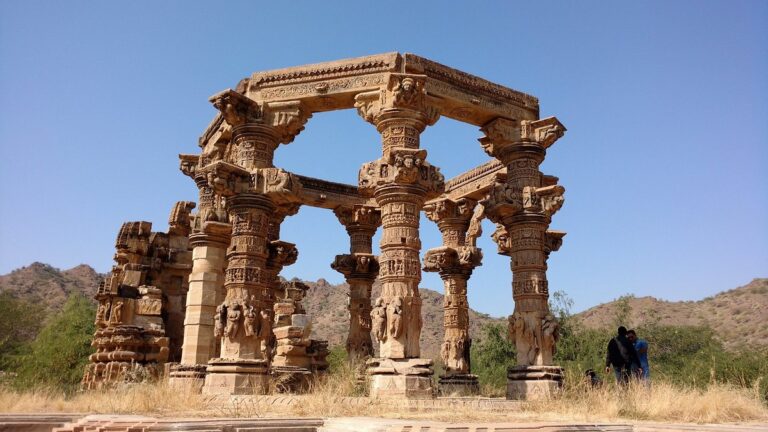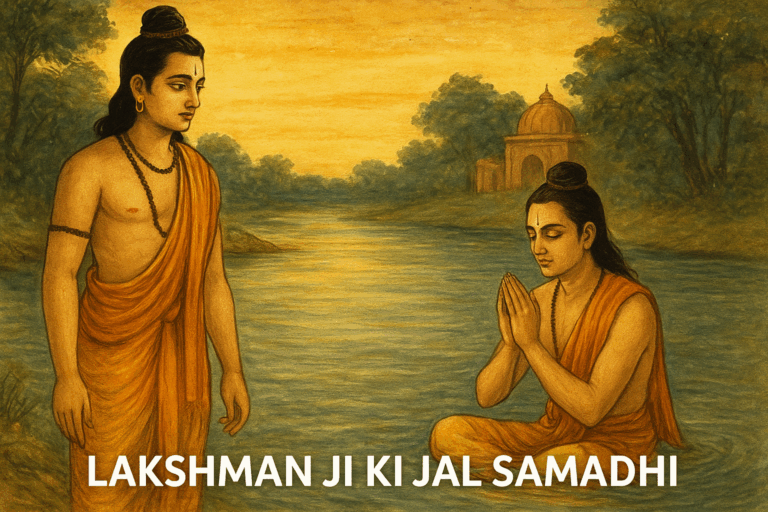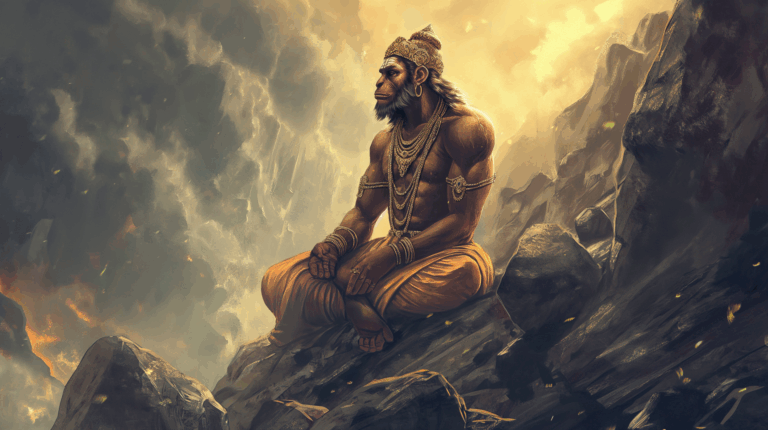When most people think of Ravana, the image that comes to mind is that of the ten-headed demon king of Lanka, the great antagonist of the Ramayana. But behind the familiar epic scenes lies a deeper, more intricate layer — one that connects Ravana not just to history or mythology, but to the subtle worlds of astrology and tantra.
Ravana is not just a character from a story; in the eyes of ancient seers, he is a coded archetype. His ten heads, his mastery of the Vedas, his rulership over Lanka, his downfall — each detail carries esoteric meaning. In astrology, he appears as a composite of planetary energies, and in tantra, he becomes a representation of the human struggle with power, ego, and spiritual awakening.
Understanding this hidden symbolism does not make him a hero, nor does it absolve his deeds. Instead, it helps us see him as the ancients might have — as a mirror for the forces we all wrestle with inside.
Ravana’s Planetary Map – The Celestial Blueprint
According to many astrological interpretations, Ravana was born under an extraordinary combination of planetary placements. His father, Sage Vishrava, was a learned Brahmin astrologer himself, and Ravana was said to have been blessed with a chart filled with strong, sometimes dangerous, alignments.
- Surya (Sun) – Symbol of authority, ego, and leadership. In Ravana’s chart, the Sun’s strength gave him royal bearing but also fueled an uncompromising ego.
- Chandra (Moon) – Associated with the mind, emotions, and intuition. His Moon placement is believed to have heightened his intellect and intuition but also made him prone to intense emotional fluctuations.
- Budh (Mercury) – Governs speech, learning, and strategic thinking. Ravana’s Mercury energy gave him the sharpness to master all four Vedas and countless shastras.
- Shukra (Venus) – Planet of pleasure, beauty, and desire. A strong Venus gave Ravana refinement, love for art and music, and also attachment to material indulgence.
- Mangal (Mars) – Warrior planet, ruling courage and aggression. Mars gave him military genius but also the tendency toward impulsive, destructive action.
- Guru (Jupiter) – The planet of wisdom and dharma. While Jupiter’s influence made him a scholar, his other planetary alignments often overpowered its moral guidance.
- Shani (Saturn) – Teacher of discipline and karma. Saturn’s role in his life is believed to have been the seed of his downfall, as karmic debts accumulated despite his power.
- Rahu & Ketu – The shadow planets. Ravana’s association with these nodes reflects his mastery over occult sciences, his understanding of tantra, and his tendency to walk paths away from conventional dharma.
In astrological symbolism, Ravana represents what happens when planetary powers are pushed to their extreme — when brilliance is not tempered by humility, and strength is not balanced with restraint.
The Ten Heads as Tantric and Astrological Symbols
In tantra, the ten heads of Ravana can be seen as representations of ten aspects of the human mind, each influenced by planetary forces:
- Kama (Desire) – Venus
- Krodha (Anger) – Mars
- Moha (Delusion) – Moon
- Lobha (Greed) – Rahu
- Mada (Pride) – Sun
- Matsarya (Envy) – Mercury
- Jnana (Wisdom) – Jupiter
- Buddhi (Intellect) – Mercury (higher function)
- Chitta (Consciousness) – Moon (higher aspect)
- Ahamkara (Ego) – Sun (dominant)
Tantrik symbolism teaches that these ten heads are not literal but are mental sheaths, layers of the human psyche that can either enslave or empower a person. In Ravana’s case, these heads were highly developed, but they were not under complete spiritual control — leading to imbalance.
Ravana’s Mastery of Astrology and Tantra
Few realize that Ravana was one of the greatest astrologers and tantriks of his age. Ancient sources credit him with composing the Ravana Samhita, a text of astrological wisdom still studied in parts of India today. He was also a devotee of Lord Shiva, performing intense tantric sadhanas to gain boons and supernatural powers.
In tantric terms, Ravana is seen as:
- A Siddha Yogi – One who had awakened many siddhis (supernatural abilities) through mantra and meditation.
- A Bhairava Upasaka – Devotee of fierce forms of Shiva, using practices to channel both creative and destructive forces.
- A Manipulator of Grahas (Planets) – Legend says he tried to control the planetary positions during the birth of his son Meghnad by forcing the planets into auspicious houses. This audacious act reflects a tantrik’s belief that destiny can be altered — but also shows the danger of overstepping cosmic law.
The Tantric Lesson in Ravana’s Fall
From a tantric perspective, Ravana’s fall was not due to a lack of knowledge but due to a lack of surrender. Tantra warns that power without surrender to the divine eventually turns on the practitioner. Ravana’s deep devotion to Shiva gave him immense strength, but his refusal to submit his ego to dharma meant that his spiritual accomplishments became fuel for his downfall.
In astrology, this is the point where malefic planets, even when strong, turn destructive if they are not harmonized with the soul’s purpose. His story becomes a living example of how planetary blessings, when misused, can create karmic traps.
Why This Symbolism Matters Today
Decoding Ravana through astrology and tantra is not an exercise in glorifying him — it is a mirror to human nature.
We all have our “ten heads”: our desires, our tempers, our ambitions, our pride.
We all have a unique planetary map that shapes our tendencies.
We all walk the razor’s edge between knowledge and wisdom, power and humility.
The lesson is timeless: Strength is a gift, but without inner discipline, it becomes a chain. Tantra and astrology are not merely about predicting the future or gaining power — they are tools for self-mastery, the very thing Ravana, for all his brilliance, could not fully achieve.
Discover more from Nav Hindu
Subscribe to get the latest posts sent to your email.

